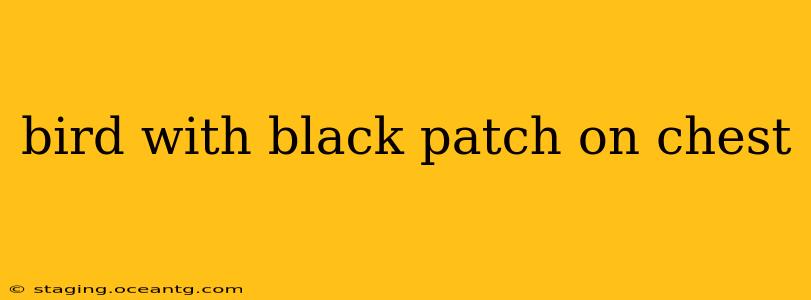Identifying birds can be a rewarding hobby, but sometimes a single feature, like a black patch on the chest, can leave you scratching your head. Many different bird species boast this characteristic, making accurate identification challenging. This guide will help you narrow down the possibilities, focusing on common species and offering key distinguishing features beyond just the black chest patch.
What are some common birds with a black patch on their chest?
This question forms the very foundation of our identification journey. Several bird species sport a black chest patch, and the location and shape of this patch are crucial for identification. We’ll explore some prominent examples below, but remember that regional variations and juvenile plumage can further complicate matters. Always consult regional bird guides for the most accurate identifications.
Some common possibilities include:
- Northern Flicker: This woodpecker is easily recognizable by its black crescent-shaped chest patch. The patch's shape, combined with the speckled back and overall size, usually makes identification straightforward.
- Brown Thrasher: While the "patch" is less clearly defined than in some species, the Brown Thrasher has a dark streaking on its breast that often appears as a dusky or dark patch, particularly when viewed at a distance. Its long tail and distinctive singing are helpful identifiers.
- Several Blackbird Species: Various blackbird species, depending on the region, can present a dark or black chest patch as part of their overall plumage. Close observation of size, beak shape, and other plumage details are essential to differentiate them.
- Various other species: Remember that many other less common bird species also feature a black chest patch, making detailed observation critical. This guide highlights common species to aid initial identification, but further research may be needed.
How can I tell the difference between birds with similar markings?
This is where careful observation and attention to detail are paramount. Focus on these key features:
- Size and Shape of the Patch: Is it a crescent, a bib, a solid patch, or something else? Note its precise location on the chest.
- Overall Body Shape and Size: Is the bird small and delicate, or large and robust? Its general size and build can be very helpful.
- Plumage Color and Pattern: Consider the overall color of the bird, its wing bars, tail pattern, and any other distinctive markings.
- Habitat and Location: Where did you see the bird? Knowing the location greatly narrows down the possibilities. A bird seen in a woodland is unlikely to be the same as one spotted in a wetland.
- Behavior: What was the bird doing? Was it foraging on the ground, hopping through branches, or flying? Behavioral clues can be incredibly useful.
What other identifying features should I look for?
Beyond the black chest patch, consider these critical distinguishing characteristics:
- Head markings: Crest, eye-rings, or distinct head patterns can greatly assist identification.
- Bill shape and size: A short, stout bill might suggest a seed-eater, while a long, thin bill might indicate an insectivore.
- Wing bars: White or colored bars on the wings can be very distinctive.
- Tail length and shape: Tail length, shape, and the pattern on the tail are useful identifying marks.
- Legs and feet: The color and size of the legs and feet are helpful, particularly for ground-dwelling birds.
Where can I find more information about bird identification?
Numerous resources are available to aid in bird identification.
- Local Bird Guides: Field guides specific to your region are invaluable. These guides often include detailed illustrations, descriptions, and range maps.
- Online Resources: Websites like the Cornell Lab of Ornithology's All About Birds provide detailed information, images, and sounds for numerous bird species.
- Local Audubon Societies: Joining or contacting your local Audubon Society offers access to experienced birders who can provide guidance and support.
- Bird Identification Apps: Several excellent apps are available that can assist in identifying birds based on images or descriptions.
By paying careful attention to detail and utilizing the available resources, identifying a bird with a black patch on its chest becomes significantly more manageable. Remember that practice and patience are key to mastering bird identification!
